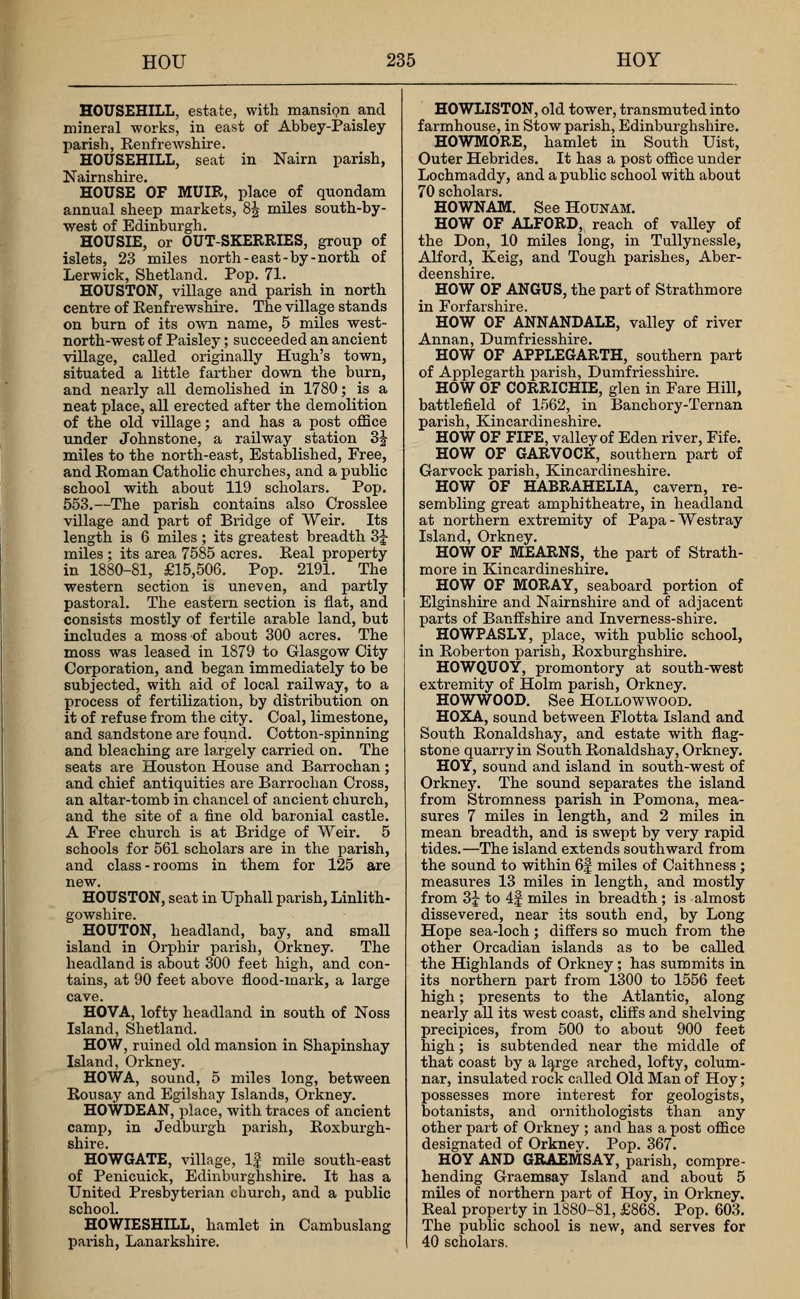HOUSEHILL, estate, with mansipn and mineral works, in east of Abbey-Paisley parish, Renfrewshire.
HOUSEHILL, seat in Nairn parish, Nairnshire.
HOUSE OF MUIR, place of quondam annual sheep markets, 8 miles south-by-west of Edinburgh.
HOUSIE, group of islets, 23 miles north-east-by-north of Lerwick, Shetland. Pop. 71.
HOUSTON, village and parish in north centre of Renfrewshire. The village stands on burn of its own name, 5 miles west-north-west of Paisley ; succeeded an ancient village, called originally Hugh's town, situated a little farther down the burn, and nearly all demolished in 1780; is a neat place, all erected after the demolition of the old village; and has a post office under Johnstone, a railway station 3J miles to the north-east, Established, Free, and Roman Catholic churches, and a public school with about 119 scholars. Pop. 553. The parish contains also Crosslee village and part of Bridge of Weir. Its length is 6 miles ; its greatest breadth 3 miles ; its area 7585 acres. Real property in 1880-81, 15,506. Pop. 2191. The western section is uneven, and partly pastoral. The eastern section is flat, and consists mostly of fertile arable land, but includes a moss of about 300 acres. The moss was leased in 1879 to Glasgow City Corporation, and began immediately to be subjected, with aid of local railway, to a process of fertilization, by distribution on it of refuse from the city. Coal, limestone, and sandstone are found. Cotton-spinning and bleaching are largely carried on. The seats are Houston House and Barrochan ; and chief antiquities are Barrochan Cross, an altar-tomb in chancel of ancient church, and the site of a fine old baronial castle. A Free church is at Bridge of Weir. 5 schools for 561 scholars are in the parish, and class-rooms in them for 125 are new.
HOUSTON, seat in Uphall parish, Linlithgowshire.
HOUTON, headland, bay, and small island in Orphir parish, Orkney. The headland is about 300 feet high, and contains, at 90 feet above flood-mark, a large cave.
HOVA, lofty headland in south of Noss Island, Shetland.
HOW, ruined old mansion in Shapinshay Island, Orkney.
HOWA, sound, 5 miles long, between Rousay and Egilshay Islands, Orkney.
HOWDEAN, place, with traces of ancient camp, in Jedburgh parish, Roxburghshire.
HOWGATE, village, If mile south-east of Penicuick, Edinburghshire. It has a United Presbyterian church, and a public school.
HOWIESHILL, hamlet in Cambuslang parish, Lanarkshire.
HOWLISTON, old tower, transmuted into farmhouse, in Stow parish, Edinburghshire.
HOWMORE, hamlet in South Uist, Outer Hebrides. It has a post office under Lochmaddy, and a public school with about 70 scholars.
HOWNAM.
HOW OF ALFORD, reach of valley of the Don, 10 miles long, in Tullynessle, Alford, Keig, and Tough parishes, Aberdeenshire.
HOW OF ANGUS, the part of Strathmore in Forfarshire.
HOW OF ANNANDALE, valley of river Annan, Dumfriesshire.
HOW OF APPLEGARTH, southern part of Applegarth parish, Dumfriesshire.
HOW OF CORRICHIE, glen in Fare Hill, battlefield of 1562, in Bancbory-Ternan parish, Kincardineshire.
HOW OF FIFE, valley of Eden river, Fife.
HOW OF GARVOCK, southern part of Garvock parish, Kincardineshire.
HOW OF HABRAHELIA, cavern, resembling great amphitheatre, in headland at northern extremity of Papa-Westray Island, Orkney.
HOW OF MEARNS, the part of Strath-rnore in Kincardineshire.
HOW OF MORAY, seaboard portion of Elginshire and Nairnshire and of adjacent parts of Banffshire and Inverness-shire.
HOWPASLY, place, with public school, in Roberton parish, Roxburghshire.
HOWQUOY, promontory at south-west extremity of Holm parish, Orkney.
HOWWOOD.
HOXA, sound between Flotta Island and South Ronaldshay, and estate with flag-stone quarry in South Ronaldshay, Orkney.
HOY, sound and island in south-west of Orkney. The sound separates the island from Stromness parish in Pomona, measures 7 miles in length, and 2 miles in mean breadth, and is swept by very rapid tides. The island extends southward from the sound to within 6| miles of Caithness ; measures 13 miles in length, and mostly from 3 to 4| miles in breadth ; is almost dissevered, near its south end, by Long Hope sea-loch ; differs so much from the other Orcadian islands as to be called the Highlands of Orkney ; has summits in its northern part from 1300 to 1556 feet high ; presents to the Atlantic, along nearly all its west coast, cliff s and shelving precipices, from 500 to about 900 feet high; is subtended near the middle of that coast by a large arched, lofty, columnar, insulated rock called Old Man of Hoy ; possesses more interest for geologists, botanists, and ornithologists than any other part of Orkney ; and has a post office designated of Orkney. Pop. 367.
HOY AND GRAEMSAY, parish, comprehending Graemsay Island and about 5 miles of northern part of Hoy, in Orkney. Real property in 1880-81, 868. Pop. 603. The public school is new, and serves for 40 scholars.

